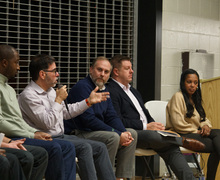Syracuse police chief seeks community help in diversifying officers
Dan Lyon | Staff Photographer
SPD is trying to find community partners in the NAACP and Spanish Action League to rewrite the SPD police entrance exam to remove questions of cultural bias by 2020, Buckner said.
Syracuse Police Department Chief Kenton Buckner wants to make the department’s demographics more reflective of the city it patrols.
He called for community help in recruiting a more diverse class of police officers at a Sept. 26 public forum, alongside Mayor Ben Walsh and Deputy Mayor Sharon Owens.
SPD recently recruited a new police class of 33 recruits. Five of the recruits are black, and one is Asian. There are six females and 27 men in the incoming class, according to a recent report.
This police class, set to graduate Dec. 3, is less diverse than the department’s last recruited class. The previous class of 36, sworn in to service in July 2018, included 11 recruits of color.
“Diversity, or lack thereof, is a major issue in terms of recruiting,” Buckner said during the meeting. “It is a community responsibility. We need everyone’s help to participate in that.”
There are 50 positions on the SPD police force that are currently vacant, Buckner said. In addition to the 33 recruits graduating in December, Buckner said recruitment for the following class is already underway. SPD is expected to take in about 35 recruits for training at the police academy beginning Jan. 17.
Buckner told The Daily Orange that he hopes to take in two police classes during 2020 to create a police department more representative of the city. Less than 10% of the over 400 officers on the SPD force are from or live in the city, Buckner said at the meeting.
“When you have officers that know the people and know the community, I feel like they can help the community better,” said Maurice Harris, a Syracuse native and community organizer, at the meeting.
Annual reports show SPD is 87% white and 85% male as of 2018. A study on racial profiling from 2010 by the University of Akron, and Syracuse University reported that African American drivers were more likely to be stopped by the SPD than any other demographic. At this time, the department was 93% white.

Eva Suppa | Digital Design Editor
SPD is trying to find community partners in the NAACP and Spanish Action League. Buckner said he hopes to use these partnerships to rewrite the SPD police entrance exam to remove questions of cultural bias by 2020.
A mission of Camp 415, an organization created by former SPD Chief Frank Fowler, is to partner with these groups and bring officers into local communities.
Another partnership Buckner hopes to build upon is with the Public Service Leadership Academy at Fowler High School. The school has a law enforcement track for high school students to prepare them for careers as police officers.
“The program focuses on building a civilian workforce by linking students with career paths in Syracuse,” said Robert Leslie, director of the Career and Technical Education program at PSLA. “(PSLA and SPD) have aligned themselves after seeing a need in more diverse police candidates.”
PSLA’s law enforcement track has an enrollment rate of 22%. Of those enrolled in CTE programs in PSLA, 59% are either black or Hispanic and 81% are economically disadvantaged, according to statistics by the Syracuse City School District.
The law enforcement track, which was created five years ago, allows students to intern for high-ranking members of SPD and engage in a curriculum focused on developing skills for police work.
But the 18-year-old graduates cannot apply to SPD until they are 21. Buckner said he believes a cadet program is needed for younger candidates to ensure they remain eligible for recruitment and stay out of trouble. Felony and certain misdemeanor convictions can disqualify candidates from being recruited.
Another change Buckner wants is the outsourcing of cultural diversity training instead of allowing the training to be taught internally by other officers. Non-police should teach certain topics, he said.
Buckner said that these initiatives to increase the amount of diverse and local police officers within the department can work to rebuild trust within the community, but this trust will take time.
“Change is difficult and police culture has been very slow and resistant to change. Just because it makes us uncomfortable does not mean we should stop,” Buckner said.
Published on October 13, 2019 at 9:57 pm
Contact Matti: mlgellma@syr.edu





